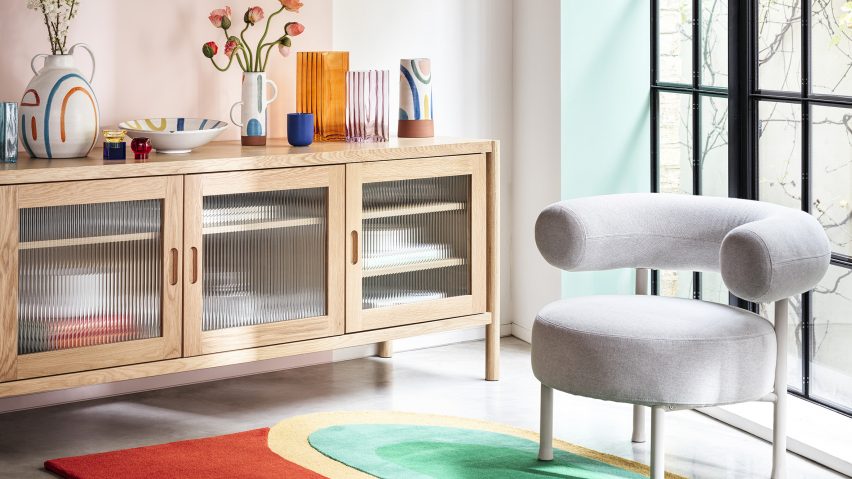British furniture retailer Habitat has revealed its 60th-anniversary collection, which features collaborations with emerging designers alongside revived archive pieces like the chicken brick.
Furniture and homeware by established designers including Sebastian Conran, Margo Selby and Tord Boontje populate Habitat's colourful 60 Years of Design collection, as well as work by newer talent such as furnituremaker Planq, ceramicist Silvia Kamodyová and artist Simone Brewster.
Novel designs rub shoulders with re-released classics in the collection from Habitat, which is an icon of British affordable design but has had a tumultuous recent history of buy-outs and store closures.
Among the revived archive products is the chicken brick from 1964 – a ceramic oven dish for steam cooking and a classic from Habitat's first year in business – updated with a matte black glaze.
Also back on the roster are the modernist-inspired 1970s Scoop chair and 2004's Ribbon light – a table lamp made of folded and powder-coated sheet steel, which according to Habitat has become a collectible.
Some of the new designs also nod to Habitat's past.
Kamodyová referenced the 1980s Graffiti sofa in the colourful markings of her ceramics while the Lattice wire chair by Habitat designer Will Hudson is based on the wicker cone chairs of the 1970s and his bright red Akari four-poster bed was inspired by early Habitat catalogues.
Other highlights include the metal Lucinda garden furniture, which has precise cut-outs intended to cast captivating shadows, and Planq's XY60 coffee and side tables with surfaces made from recycled denim waste and legs in bright pops of blue or yellow.
Habitat designer D'arby Mawson's Cayan salt and pepper grinders look like a sculptural version of a wooden stacking game, while Brewster's bold-hued rugs are based on her own hand-paintings of the female form.
Sebastian Conran's contribution is a series of four lighting designs – including one inspired by the bulbous shapes of the Michelin Man – while Felix Conran designed mirrors with the gently contoured lines of river stones and Selby applied her graphic pattern designs to a range of textiles and bedding.
Habitat's head of design Andrew Tanner said that the brand's 60th anniversary offered an opportunity for the team to "look back and celebrate the last sixty years of Habitat's rich heritage".
"It's allowed us to reimagine classics from decades past for how we live now, as well as conceive new and thoughtful pieces that we hope will become collectables and represent the next generation of design," he said.
Habitat was founded in 1964 by Terence Conran, the highly influential British designer and retailer who also founded The Conran Shop, Benchmark Furniture and London's Design Museum.
In its first three decades, it helped to revolutionise British home decor tastes with its modern, clean-lined and European-inspired furniture and homewares.
But since then, the company has struggled and was sold three times over – first to IKEA in 1992, then to restructuring company Hilco in 2009 and finally to the Home Retail Group in 2011, which now largely sells the brand's products through its Sainsbury's and Argos stores and online.
However, contrary to Elle Decoration editor Michelle Ogundehin's proclamation that the brand was "as good as dead" after the last sale and Conran's own observation that his "love child, Habitat, appears to be dying", the company has persevered.
Tanner expressed optimism for Habitat's future and said that the company is in a better position now than ever before to create products that are true to its vision.
"Habitat has always championed great design and was founded on the concept of quality homeware that turns heads," Tanner told Dezeen. "We want to continue to be known for this moving forward. We are able, like never before, to create design-led products that are accessible and affordable to all."
Other highlights from Habitat's past include the first collection of former creative director Polly Dickens in 2012, which aimed to take the brand back to its "original Conran days" after the takeovers, and a VIP for Kids range that touted designs by the likes of actors Kate Winslet and Daniel Radcliffe.

